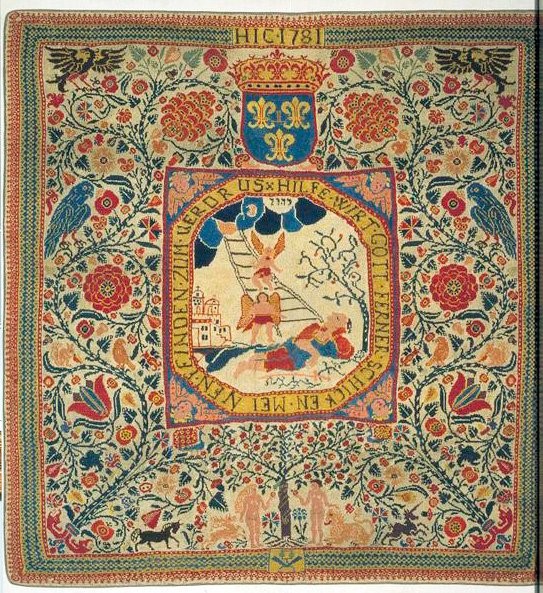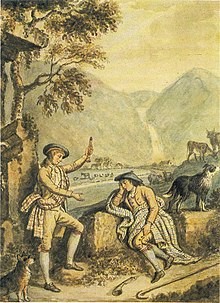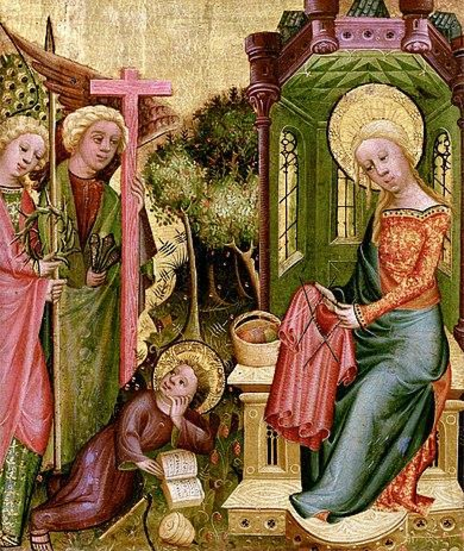The second in a series of four posts on the origins of and developments in hand knitting
It is believed that knitting techniques from Coptic Egypt influenced Islamic art, and that knitting found its way to Europe from northern Africa, possibly with the Moorish invasion and conquest of Spain. From Spain, knitting was likely to have made its way throughout Europe. By the 14th century, knitting appeared in European artwork. In 1348, the first of several paintings known as the Knitting Madonnas was painted in Siena. The paintings indicate that knitting was known in Italy and Germany in the 14th century, but historians note that not much more can be determined.
Archeological finds from medieval cities throughout Europe, including London, Amsterdam, Lübeck, and Oslo document the spread of the knitting of items for everyday use, beginning in the 14th century. These findings are supported by local tax listings as well. With many archaeological textile finds, however, many are only fragments, meaning that their original appearance or use is often not evident.
Caps seem to have been the first items of clothing to be hand knit in England, with Coventry caps traced to the 13th century (example of Monmouth cap pictured below dates from somewhat later – the 16th century). The popular Welsh Monmouth caps were knitted in the round on four needles, in stockinette, and then felted. Stockings and mittens appeared around 1387, but it is unclear whether these were knitted or made by nålbinding.

As knitted garments became fashionable and sought after by the wealthy class, professional guilds started to appear, with men controlling the development of the craft and the market. The craftsmen of the guilds were required to pass rigorous tests to demonstrate a high level of skill before membership was granted. The earliest guilds were established in France by the mid-13th century.

Elsewhere in Europe knitting guilds appeared as well. Craft guilds were set up in the Netherlands in 1429, and by the mid-16th century, Dutch stocking knitters were so skilled that the King of Denmark hired them to teach their technique to Danish knitters. English knitted stockings were exported in quantity by this time but there were no knitters’ guilds in that country. Knitting was established in the Scottish lowlands by the 15th century. The history of Scottish knitting basically paralleled that of the English, although Dundee bonnetmakers formed a trade guild in 1496. [ See my post on the Scots Blue Bonnet – https://www.thismanknits.com/2024/03/26/the-scots-blue-bonnet-an-early-hand-knitting-industry/ ]

The craft was known in Germany and Austria by the 13th century and in northern Italy by the mid-14th century. In Britain, knitted liturgical gloves, dating from the 14th or 15th century, similar to those found in Spain and France, are part of the collection of St. Paul’s Cathedral in London.
As early as 1500 Dutch whalers, based in Shetland during the fishing season, traded food for Shetland sweaters. On Gotland Island, in the Baltic Sea southeast of the Swedish mainland, the early appearance of knitting is attributed to Gotland’s role as a major trade center during the late Middle Ages.
In the Baltics woolen gloves and mittens were found in both Estonia and Latvia, dating from this time.
By this time demand for knitted socks was so great in many regions that a cottage industry developed. Peasants were able to enhance their standard of living by knitting woolen socks for the landed gentry. As the craft passed into the hands of women, they began to also knit garments for their own families.
During the 15th and 16th centuries, knitting designs in France had lost the more primitive Arabic appearance. An ornateness appeared in coats and jerkins, and by the late 16th century, knitted silk stockings were worn by the members of the court of Charles IX. The earliest purled stitches that have been documented were seen on the stockings of Eleanora of Toledo (1562).
Beginning in the mid part of the 16th century the purl stitch was used in a decorative way. Shaping also was incorporated into hand knitting technique around this time. Cap knitters of the 16th century used 3-dimensional shaping as they worked in the round.
In the mid-16th century, Henry VIII’s flagship, the Mary Rose sank. Over 400 years later, the contents were raised from the seabed, and among them were found several pieces of knitting that demonstrate a high level of craftsmanship and knowledge of knitted shaping. Knitted pieces similar to those recovered from the Mary Rose have been found at 16th-century sites around London.
By this time, knitting was well established throughout Europe and in other parts of the world that were influenced by Europe through voyages of discovery and trading routes.
It has been written that by the end of the 16th century, nearing the end of the Queen Elizabeth’s reign, knitting occupied nearly half the spare time of farmers in the Midlands of England, and that England was the leading producer of knit stockings.
At this same time, William Lee had invented the knitting frame, but was refused a patent by Queen Elizabeth, who felt that it would threaten the livelihood of poor hand knitters around the country.
Next up: Knitting in Europe between 1600 and 1800
Sources
Buss, Katharina. Big Book of Knitting. New York: Sterling Publishing Co., Inc., 2001.
Coleman, Ava T. “How It All Began.” TKGA.com. Cast On August-October 2008: 12-13. 28 August 2016 https://tkga.site-ym.com/global_engine/download.asp?fileid=AC65D860-440E-4B58-B61D-5AA5D4FE9577&ext=pdf
Forte, Mary. “Fair Isle: A Quick History.” TKGA.com. Cast On February-April 2009: 10-11. 28 August 2016 https://tkga.site-ym.com/global_engine/download.asp?fileid=C803C6CC-8258-4801-AB91-8F38219A1AF7&ext=pdf
Gibson-Roberts, Priscilla A., and Deborah Robson. Knitting in the Old Way: Designs & Techniques from Ethnic Sweaters. Fort Collins, CO: Nomad, 2004.
Macdonald, Anne L. No Idle Hands: the Social History of American Knitting. New York: Ballantine, 1988.
Nargi, Lela. Knitting around the World: A Multistranded History of a Time-honored Tradition. Minneapolis: Voyageur, 2011.
Rutt, Richard. A History of Hand Knitting. London: B. T. Batsford Ltd, 1987.


